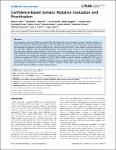Confidence-based Somatic Mutation Evaluation and Prioritization
Löwer, Martin
Renard, Bernhard Y.
Graaf, Jos de
Wagner, Meike
Paret, Claudia
Kneip, Christoph
Türeci, Özlem
Diken, Mustafa
Britten, Cedrik
Kreiter, Sebastian
Koslowski, Michael
Castle, John C.
Sahin, Ugur
Next generation sequencing (NGS) has enabled high throughput discovery of somatic mutations. Detection depends on experimental design, lab platforms, parameters and analysis algorithms. However, NGS-based somatic mutation detection is prone to erroneous calls, with reported validation rates near 54% and congruence between algorithms less than 50%. Here, we developed an algorithm to assign a single statistic, a false discovery rate (FDR), to each somatic mutation identified by NGS. This FDR confidence value accurately discriminates true mutations from erroneous calls. Using sequencing data generated from triplicate exome profiling of C57BL/6 mice and B16-F10 melanoma cells, we used the existing algorithms GATK, SAMtools and SomaticSNiPer to identify somatic mutations. For each identified mutation, our algorithm assigned an FDR. We selected 139 mutations for validation, including 50 somatic mutations assigned a low FDR (high confidence) and 44 mutations assigned a high FDR (low confidence). All of the high confidence somatic mutations validated (50 of 50), none of the 44 low confidence somatic mutations validated, and 15 of 45 mutations with an intermediate FDR validated. Furthermore, the assignment of a single FDR to individual mutations enables statistical comparisons of lab and computation methodologies, including ROC curves and AUC metrics. Using the HiSeq 2000, single end 50 nt reads from replicates generate the highest confidence somatic mutation call set.
No license information

